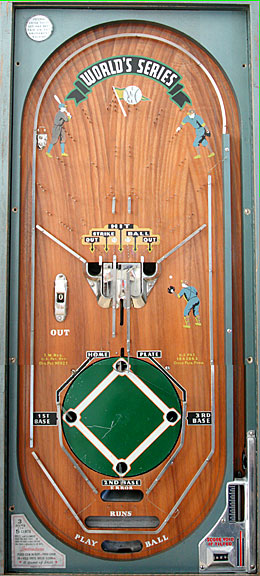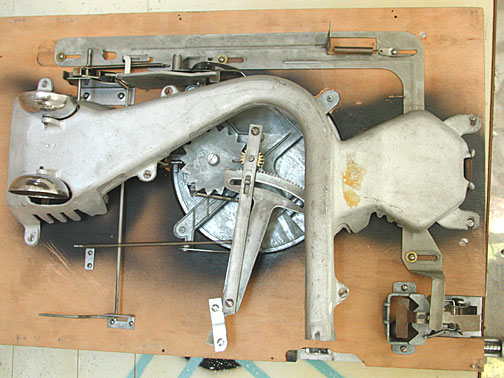World Series (Rockola 1934)
(visit YouTube to see the World Series in action)

Description of Play
Rockola's World Series (1934) allows you to play half an inning of baseball for one penny. The game keeps track of the number of outs and stops play after three outs. It keeps track of the number of strikes and balls and puts a man on base when there is a hit. Men on base progress around the diamond and the game even allows for doubles, triples, and home runs. Finally the game will keep track of the number of runs scored. This is a half inning of baseball with all the same frustration and thrills of a real game.
The player first inserts a penny and pushes in the coin slide to start the game. The tilt indicator, put there to discourage aggressive shaking of the game is reset and any runners left on base or runners that have scored from the previous game are ejected and disappear under the playfield.
The player loads the first ball by pushing in the ball lift plunger and shoots the ball with the ball shooter. The ball makes a complete circuit of the playfield, surpring many players, and then drops into the top portion of the playfield. Here it bounces from pin to pin, making its way to the tip table. Here the ball can drop into one of the out holes, causing an out, or it can fall into the balls or strikes slot. The player hopes the ball will travel down the middle of the area, through a gate, and will fall into the home plate hole of the diamond. Should it make it to home plate, the diamond will rotate the ball to first base, indicating a hit!
The diamond rotates the runner through successive hits around the diamond, to first, second, third, and finally home again. It is possible to surprise the player by rotating more than a single base as occasionally the diamond will rotate two, three or even four positions. These make it look like the batter got a double, triple, or even a home run.
Once the ball representing the runner has rotated past third base, the ball is slowly elevated out of the hole and is guided to the bottom of the playfield where the runs are counted. At the end of the game, a player can count the number of runs and add it to his score.
Should the first ball played only fall into the balls or strikes slots on either side of the center, these balls will show the batter's count. Notice how the third ball in the strike slot will roll off into the out hole. As you might expect, the third strike results in an out. Also note how the fourth ball will roll into the center lane, putting a man on first like a walk, just like in a real game! (Unfortunately, the game is unaware of a base on balls and will sometimes progress the walked batter two, three or even four bases. Oops.)
There are some other limits in the games ability to simulate a real baseball inning. There are only ten balls in the game, so it is not possible to get more than ten runs in an inning. In fact it is unlikely to even get ten runs as the last man on base would have to result in a home run, also unlikely.
There are several anti-cheat mechanisms designed into the game. The game will not allow play to commence until the coin slide is fully retracted. This prevents someone from wiggling the coin slide in hopes of starting another game or continuing on in a game with three outs already. The third out prevents any balls from being lifted into play. Once the third out has occurred, a post blocks further balls from entering the diamond and scoring runs. This prevents a player from shooting many balls in the hopes many will fall down the center and will score, even if the third out occurs. Transparent fingers cover the balls when on base, to prevent the player from jiggling the game and causing the ball to go to an advanced base. There is the obvious tilt mechanism that prevents aggressive shaking of the game.

Internals
Rockola World Series has seven different mechanisms under the playfield in order to accomplish all the intricate rules. Each mechanism was carefully designed and manufactured. The game was reliable, even when played thousands if not tens of thousands of times. The game is almost as beautiful under the playfield as it is above.
The explanation of the game shows the various functions happening underneath the surface of the playfield. Each mechanism has a different colored arrow pointing to it. The links below take you directly to the explanation of the listed mechanism.
- (yellow) reset when the coin is inserted ( and other anti- cheat devices)
- (dark blue) tilt mechanism that indicates excessive shaking of the game
- (red) winding mechanism that powers the turn table
- (light blue) the turn table itself, that rotates the runners around the baseball diamond
- (green) star wheel that makes the doubles, triples, and home runs happen
- (purple) the balls and strikes tilt table that keeps track of the count
- (orange) out counter that keeps track of how many outs and at three, prevents further play
For those of you really curious about how the various parts work or fit together, there is a another detailed set of pictures, including areas not seen in the previous set of pages.
There are also two sequences that show how the tilt mechanism and the balls and strikes mechanism works.
